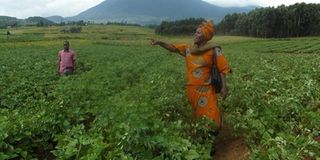Scientists make breakthrough in blight-resistant Irish potatoes

A farmer in her Irish potato garden in Kisoro. Late blight causes significant yield losses in Irish potato-growing areas of the country. FILE PHOTO
National Agricultural Research Organisation (Naro) is in the process of breeding Irish Potato varieties that are resistant to late blight, a fungal disease ravaging the crop in farmers’ fields across the country.
Via transgenic technology, two varieties are being studied by scientists at Naro’s Kachwekano Zonal Agricultural Research and Development Institute (KZARDI), which is located in Kabale.
The varieties being tested are commonly grown in the country, namely Victoria from Uganda and Désirée from Kenya.
Work started with a mock trial last year. So far, two confined field trials have been conducted at the Institute and the results are promising, explained Dr Alex Bareke, a researcher at KZARDI.
He was explaining the process during the Biosafety Forum, organised by Uganda National Council for Science and Technology (UNCST), and held in Kampala last week.
Genes for resistance against late blight were introduced into the varieties in the laboratory at International Potato Centre (CIP), which is based in Lima, Peru. The genes were obtained from the wild relatives of the Irish Potato from South America—Solanum bulbocastanum and Solanum venturii.
Potato tubers, which were planted at the Institute, were obtained by KZARDI from Peru through African Agricultural Technology Foundation.
The mock trial was done in March 2014 and the harvest was in May the same year; and the real trial was done in June 2015 and harvest in September that same year.
Dr Bareke says the tests were done against late blight, which is rampant in high altitude areas where the disease causes 40–60 per cent yield loss in the farmers’ fields.
The varieties being tested are early maturing—taking three to four months from planting to harvest time—and can grow in marginalised soils. They are high yielding but succumb easily to late blight.
However, there are other Irish potato varieties grown by farmers namely Rutuku, Kisoro, NAKPOT 1, NAKPOT 2, NAKPOT 3, Kruzer and Sangema. They are tolerant to late blight but are not as high yielding as Victoria.
Dr Abel Arinaitwe, the lead researcher, explained that during the field trial, the transgenic plants are planted in a row alongside non-transgenic plants and left to be infested by late blight naturally.
During the second month, non-transgenic varieties were heavily infested by the leaf blight, which destroyed them. But the transgenic varieties showed 90 per cent resistance.
Now, the team is going to carry out one more trial, and thereafter conduct multi-locational trial in different geographical areas where Irish potatoes are grown. These are to ascertain how the varieties in development will adopt to these locations.
He said that scientists in The Netherlands have used this technology in their laboratories with promising resuts.
Late blight is favoured by temperatures accompanied by heavy dew or rain. The disease attacks leaves, stems and tubers consisting of small, pale and dark green spots that change into brown or black lesions, depending on the humidity of the air.
Under conditions of high humidity and cool temperature, lesions look water soaked and expand rapidly. It is more damaging during cool, wet conditions.
Other diseases that destroy the crop include leaf blight, tuber bacterial blight, bacterial ring rot and knot root. There are also pests such as potato leaf hoppers, aphids and beetles.
In addition to growing suitable varieties, farmers are advised to use good agronomy practices such as mulching, removal and burning of infested plants and application of fungicide through spraying.
The most important measures are cultural control, use of resistant varieties, chemical control and integrated disease management.
Integration of late blight management has often been thought as one of the better disease management options in tropical regions, where fungi are abundant in most months of the year.
The situation
In Uganda, about 300,000 smallholder households grow potatoes for their subsistence living and for income. Loss due to late blight can be up to 60 per cent in Uganda forcing farmers to spray fungicides often up to 15 times to protect their crops. This represents between 10-25 per cent of their revenue from potato.
Recently, a new population of the pathogen is sweeping through Uganda that appears to be more difficult for farmers to manage. Hence, the pressure on farmers to grow resistant varieties is escalating.
A few resistant varieties exist but they are not the preferred varieties that farmers and consumers want.
Moreover these resistant varieties still rely on the use of fungicide. However, a scientific breakthrough in 2003 changed the prospect for obtaining durable resistance to late blight disease.
A resistance (R) gene was isolated from Solanum bulbocastanum, a wild relative of the potato found in Mexico, and shown to confer resistance to a broad spectrum of pathogen strains.
Soon after the discovery more R genes were isolated paving the way to obtain durable resistance to late blight in potato using biotechnology.
Today we use genetic engineering, transgenesis, more commonly known genetic modification (GM), to introduce three R genes with broad spectrum resistance from wild relatives of the potato into potato varieties preferred by farmers and consumers alike.




